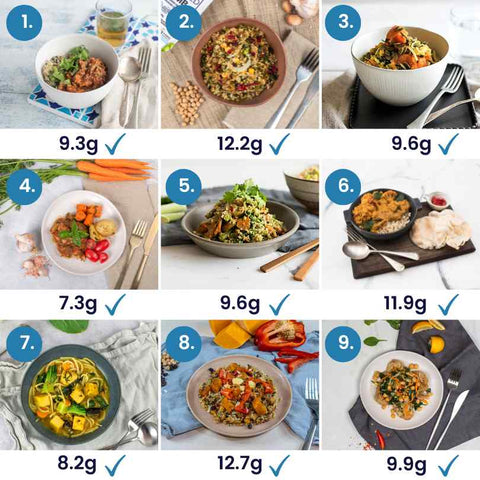In previous blogs (‘What is fibre and how much do we need? and Tips to Boost your Fibre Intake’), we’ve explored the Australian dietary fibre guidelines, how much we should be aiming for and tips to boost your intake. In this blog, our expert dietitian Marnie explains the different types of dietary fibre, sources found in gluten free foods, and the unique ways they contribute to our health.
Most of us think of fibre as something for keeping us regular. But experts agree – fibre is so much more than this! A huge field of research shows that different types of fibre work in different ways, to improve our health.

The above meals are an excellent source of fibre with at least 7g of fibre or more per serve.1. Moroccan Chicken (GF & LFM)2. Greek Shredded Lamb & Grain (GF)3. Roasted Sweet Potato & Cauliflower (GF)4. Fish in Tomato, Basil & Green Olive Sauce (GF & LFM)5 Thai Green Curry (GF & LFM)6. Pumpkin & Lentil Dahl (GF)7. Tofu Laksa (GF & LFM)8. Pumpkin & Grain (GF)9. Roasted Spiced Cauliflower & Chickpea (GF)
Soluble fibre
This type of fibre dissolves in our gut, and tends to have gel-forming properties, which can help us feel fuller, help with stool bulking and softening, and even reduce cholesterol absorption and help with blood sugar management.
Examples of good soluble fibre sources: (* = low FODMAP)
- legumes (e.g. lentils, chickpeas, kidney beans)
- Some fruits e.g. apple, avocado, kiwi*, orange*, pears, prunes
- Some vegetables e.g. sweet potato*, eggplant*, Brussel sprouts
- Ground linseed* (flaxseed) and chia seeds*
- Most nuts, e.g. like walnuts*, almonds* and peanuts*
- Psyllium* and fibre supplements like Metamucil®, Benefibre®
Insoluble fibre
This type of fibre comes from the plant cell wall that we just can’t digest. It helps by adding bulk and holding water in the stool, which keeps things moving through our gut, and helps us remove waste products from our body – a bit like a broom!
Examples of good sources of insoluble fibre: (* = low FODMAP)
- Most fruits and veggies, especially higher ‘roughage’ and seeded types e.g.
- Pineapple*, strawberries*, rhubarb*, kiwi*
- Corn*, green beans*, broccoli*, kale*
- Nuts, seeds and legumes contain both insoluble fibre and soluble fibre
- Brown rice*, quinoa*, buckwheat*, coconut flour, whole grain GF bread
- Rice bran*, whole linseeds*, millet*, amaranth*
Resistant starch
This fibre type is a bit different. Most starchy foods are easily broken down and absorbed, but resistant starch is a type our bodies aren’t able to process, so it travels through the gut and ends up being fermented by gut bacteria. This can have lots of benefits for our gut lining and our microbiome (see next weeks Fibre Part 4 Blog on prebiotic fibre).
Good sources of resistant starch include: (* = low FODMAP)
- Cooked and cooled starches eg. rice*, potato*, GF pasta*, GF bread*
- Legumes like lentils, chickpeas, black beans (*tinned, ¼ cup is low FODMAP)
- Less ripe bananas*, green banana flour
- Less processed GF grains/cereals e.g. brown rice*, wild rice*, corn grits*
- Some high fibre GF products enriched with resistant starch eg. HiMaize®
Next week, we'll explore what all the fuss is about prebiotic fibre and what this means for someone following a gluten free diet!
---------------
As always, consult with an experienced Accredited Practising Dietitian for personalised advice about fibre and your health.
